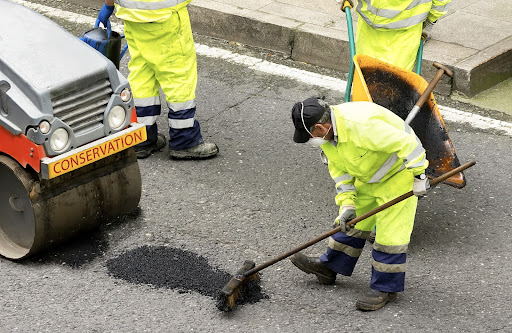
Pothole patching is necessary for road, driveway, or pavement repair. Unfortunately, not many people know exactly what this process involves.
Pothole patching is simply the process of filling potholes in the asphalt ground. Potholes are a nuisance to both drivers and pedestrians. They are unsightly and can lower the value of any property.
Additionally, potholes are safety hazards. Drivers who pass over them can hurt themselves and their passengers. Pedestrians can slip or trip over them, especially when they go unnoticed. Plus, potholes can cause vehicle damage, leading to costly repairs. In fact, in 2021 alone, pothole-related vehicle damages cost drivers $26.5 billion in repairs.
With all these consequences, pothole repair is not just a luxury but a necessity. Whether it is patching potholes with concrete or asphalt, it is crucial to act fast. This way, you can prevent the pothole from expanding or even multiplying.
Repairing potholes is paramount to people’s safety and vehicles’ protection. But there are a few ways to patch potholes. The most common ones are the throw-and-go method, the throw-and-roll method, the semi-permanent method, and the spray injection method.
The throw-and-go method is perhaps the most commonly used pothole patching technique. It is a popular choice mainly due to its low cost and ease of application. Using this method, pothole patching materials are shoveled into the pothole.
As its name suggests, there is no need to prepare the pothole, so it may still include water and debris. The patching materials are shoveled into the hole until it is filled. Then, you will rely on passing traffic to fully compact the material, though you can use a shovel to compact it lightly.
A similar yet more effective pothole patching procedure than throw-and-go is the throw-and-roll. This method follows the steps of the throw-and-go method.
You shovel materials into the unprepared pothole until properly filled. Then, you run a heavy vehicle over the patched pothole to compact it. Typically, you use the maintenance truck for this. Following compaction, you must then check that there is a visible crown. The crown should measure about 0.125 to 0.25 inches.
This driveway patch method is superior to the throw-and-go method because it allows for a tighter patch. This contributes to the longevity of the result.
The third method for patching pavement is called the semi-permanent method. Many experts consider this the best method, next to a full replacement.
Using this method, you must first remove debris and water from the pothole. This way, the patch can last longer. The sides of the hole are then squared so that the depth reaches where the pavement is sound. You then fill the pothole with the appropriate material before compacting it with a smaller tool than the patch area. The most commonly used tools include single-drum vibratory rollers and vibratory plate compactors.
It is important to take extra precautions when using this method, though. Preparing the pothole for patching involves the removal of debris and the squaring of the sides. As such, rocks and debris may be blown away and hit oncoming traffic. Additionally, following completion, you should sweep away loose gravel from the site.
Because the semi-permanent method prepares the pothole for patching and uses a compactor, its results are more long-lasting. However, due to the nature of this method, you should expect to pay higher equipment and labor costs.
The final road patching process is called the spray injection method. This is the best method for transverse potholes or cracks.
To use this method, you must first prepare the pothole, similar to the semi-permanent method. You must remove all the debris and water from the pothole for a cleaner canvas. You will then spray a tack coat of binder on the bottom and sides of the pothole. After that, you will need to spray asphalt and aggregate into the pothole. Another layer of aggregate follows.
Patching potholes in the driveway can be time-consuming, especially when compacting the patch area. But, with the spray injection method, compaction is not needed. However, because of the materials and equipment involved, this method comes at a much higher cost.
When it comes to repairing anything, there is always this notion that doing it yourself is the better option. People seem to think that the DIY route will allow them to save money while still accomplishing the task at hand. But, while doing it yourself can save you money in the short term, professional pothole patching is a long-term investment.
Professionals have the knowledge and experience needed to achieve effective results. They go through pothole patching training and continue to learn new techniques. They know how to repair a pothole in the road, driveway, or sidewalk. When it comes down to it, professionals can get the job done with minimal to no errors at an efficient rate.
But, when you do it yourself, there is a huge risk of making mistakes, especially if you don’t know what you are doing. Mistakes may seem like nothing but can result in costly damages. Ultimately, you will have done more harm than good and be forced to shell out even more money.
Pothole patching can also be dangerous. If you want results that last, you will need the right equipment and materials. More often than not, the DIY approach does not give you access to these resources. On the other hand, professionals have all of these at their disposal.
Pothole patching is a must if you want to preserve the beauty of your asphalt surface, protect drivers and pedestrians, and safeguard vehicles. Instead of attempting to do it yourself, it is always better to seek professional assistance. In doing so, you can guarantee better results and save money in the long run.
RELATED ARTICLES: